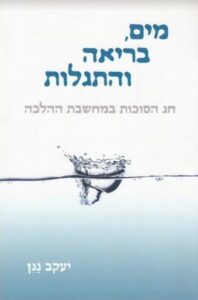Alt+SHIFT: Water, Creation, Immanence

Alt+SHIFT is the keyboard shortcut allowing us quick transition between input languages on our keyboards—for many readers of TRADITION that’s the move from Hebrew to English (and back again). Yitzchak Blau continues this Tradition Online series offering his insider’s look into trends, ideas, and writings in the Israeli Religious Zionist world helping readers from the Anglo sphere to Alt+SHIFT and gain insight into worthwhile material available only in Hebrew. See the archive of all columns in this series.
Yakov Nagen, Mayim, Beriah ve-Hitgalut: Hag ha-Sukkot be-Mahshevet ha-Halalakha (Maggid Books, 2013)
Yakov Nagen’s prolific output includes books on the Mishna, spirituality, attitudes to other faiths, and the volume profiled here, on Sukkot. Nagen combines academic tools with a search for religious meaning and he successfully integrates the worlds of mysticism and rationalism.
This volume, whose Hebrew title might be rendered as Water, Creation and Immanence: The Philosophy of Sukkot, argues that both the sukka and the four species resonant with Mikdash imagery. The sukka stands in for the Temple while the lulav and etrog represent a sacrificial offering. Beyond the specific thesis, the work is methodologically interesting. Philosophical explanations of mitzvot may seem like an overly speculative endeavor but Nagen contends that we can utilize halakhic details to more rigorously establish a hashkafic interpretation. Secondly, he assumes that derashot in which we extrapolate halakhot from one mitzva to another are not just technical apparatuses but rather reflect a deeper connection between the two. The cumulative impact of a wide range of proofs makes his central ideas convincing.
R. Eliezer states that a Jew who missed the obligatory meal on the first night of Sukkot can eat a make-up meal on Shmini Azteret (Sukka 27a). We usually limit the concept of tashlumin for sacrifices or prayer, which is itself modeled after the sacrificial order. Ritva explains that we compare the sukka meal with a hagiga offering; therefore, it has a make-up date. R. Yehuda ben Beteira explicitly derives the prohibition on using parts of the sukka for personal benefit from the korban hagiga (Sukka 9a). These concepts associate the sukka with the world of sacrifices.
 Other sources generate a parallel between the physical structure of the sukka and the Mikdash. At one point, R. Eliezer obligated men to eat two daily meals in the sukka. According to the Yerushalmi (Sukka 2:17), he derived this from the phrase “shivat yamim” (seven days) appearing with regard to both the tent of meeting and the sukka. Furthermore, the sukka becomes a place of divine revelation. The Talmud derives the minimum height of a sukka from the Shekina‘s place around the ark (Sukka 4b). According to one tanaitic opinion, the sukkot in the desert were not actual booths; instead, they were clouds of glory (Sukka 11b). As Nagen points out, these mystical clouds allude to the presence of God (Numbers 14:14).
Other sources generate a parallel between the physical structure of the sukka and the Mikdash. At one point, R. Eliezer obligated men to eat two daily meals in the sukka. According to the Yerushalmi (Sukka 2:17), he derived this from the phrase “shivat yamim” (seven days) appearing with regard to both the tent of meeting and the sukka. Furthermore, the sukka becomes a place of divine revelation. The Talmud derives the minimum height of a sukka from the Shekina‘s place around the ark (Sukka 4b). According to one tanaitic opinion, the sukkot in the desert were not actual booths; instead, they were clouds of glory (Sukka 11b). As Nagen points out, these mystical clouds allude to the presence of God (Numbers 14:14).
Of course, all this combines with a contrasting theme—the sukka acting as our regular home for the duration of the holiday. The derasha of teshvu k’ein taduru (treat the sukka like your house) may be the source for a host of obligations and exemptions. One should bring nice utensils into the sukka, while the sick, the bothered, those on a business trip, and those guarding the fields all receive some degree of exemption. That the sukka becomes both the Temple and a regular domicile can be complimentary rather than contradictory ideas; we are meant to convert our home into a holy structure.
Moving to the four species, a good deal of evidence sees them as a kind of korban. R. Abbahu taught in the name of R. Elazar that anyone who takes lulav and hadasim properly is considered as if he built an altar and offered sacrifices (Sukka 45a). The Torah itself links the four species with the Temple by generating a longer, seven-day obligation to rejoice with them “before God” as opposed to a one-day obligation outside the Temple area (or outside Jerusalem, an extension of the Mikdash). Once again, halakhic details help bolster the thesis. A stolen lulav is invalid as a mitzva ha-ba be-avera, a concept derived from verses about the sacrificial order and that may be limited to sacrifices (Sukka 30a). Ritva explains that there is a ritzuy (prayer/offering) element to taking the four species, which is how that invalidation applies to the stolen lulav. Another Gemara speculates that taking the four species would be a commandment incumbent on the community and not on each individual (Sukka 41b). Why should we have ever thought so? R. Yaakov Ettlinger (Arukh la-Ner) explains that we initially thought the four species represent a communal offering and not a personal obligation.
Nagan also employs fine literary sensitivity to add support. The Talmud refers to physically blemished lulavim as ba’alei mum (blemished), a term borrowed from sacrifices. A different passage describes unblemished lulavim as “temimim,” another term from the world of korbanot. Deliberate word choice heightens the connection, and our author is sensitive to literary placement. The third and fourth chapters of Mishnayot Menahot catalogue when different components of given mitzvot are crucial for performing any given command. For example, the absence of tekhelet strings does not nullify a tzitzit of white strings (Menahot 4:1). The Mishna places the discussion of the four species among other items within the sacrificial order (3:6) and not in the context of regular mitzvot (3:7), indicating a korban-like quality to the four species. This placement point was already noted by R. Yisrael Lipschutz in his Tifferet Yisrael.
Some of the other claims were less convincing to me. Nagen thinks that the sukka mitzvot include several Gan Eden allusions and that the word “shoeva” in the simhat beit ha-shoeva refers not to drawing water but to drawing divine inspiration. In any case, he not only provides insight into the Sukkot holiday, but he also presents a model for integrating different disciplines in a manner that combines academic rigor with spiritual concerns. We look forward to more of his productive efforts.
Yitzchak Blau, Rosh Yeshivat Orayta in Jerusalem’s Old City, is an Associate Editor of TRADITION. Read his review of Nagen’s earlier book, Be, Bless, Become.
